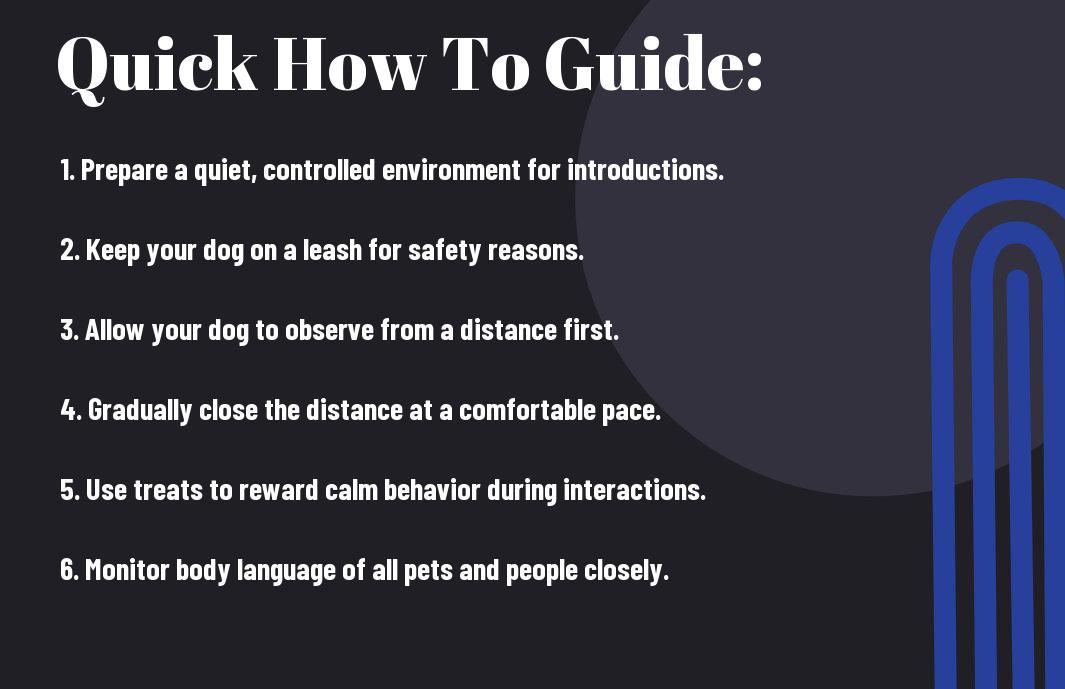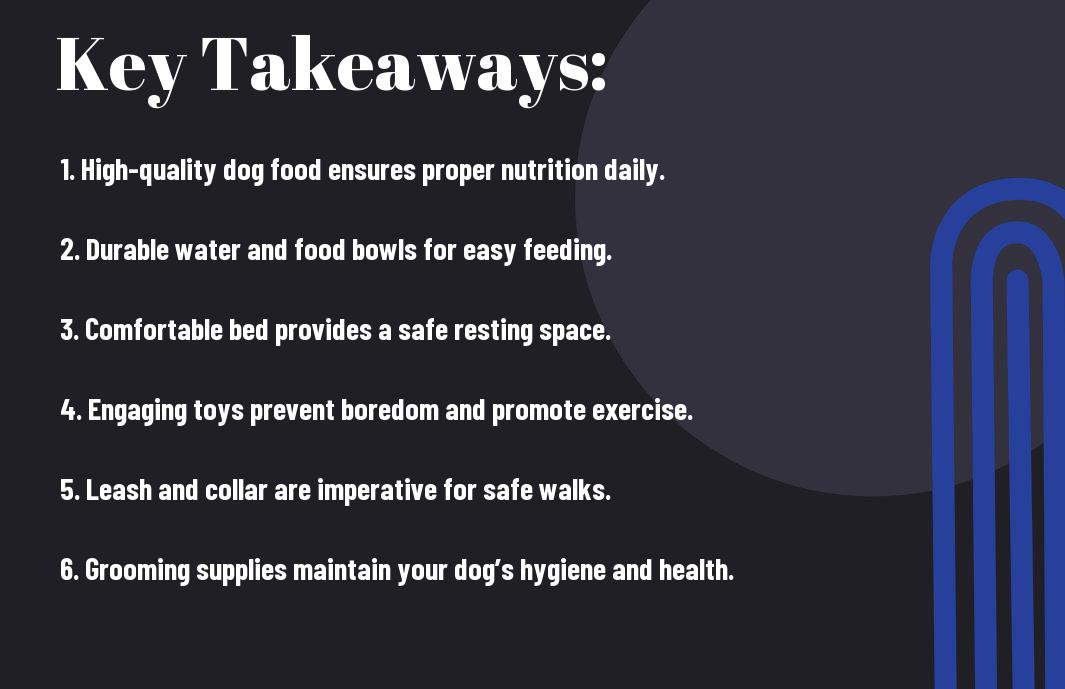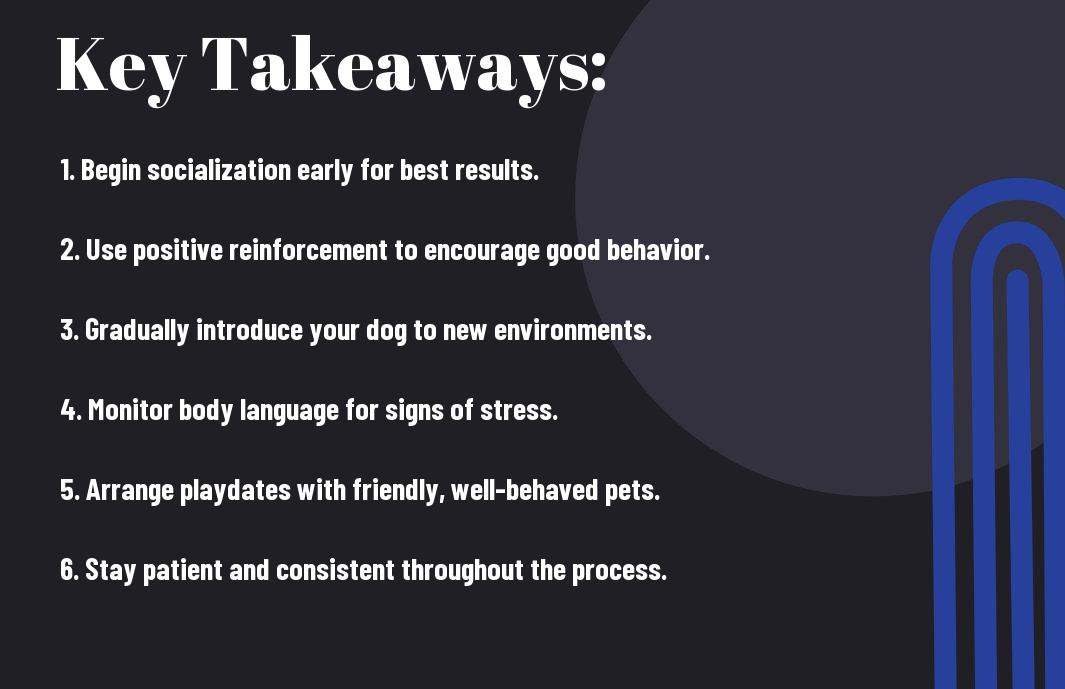Many dog owners face the challenge of introducing their furry friends to new pets and people. This process can be both exciting and a bit nerve-wracking, as your dog’s safety is paramount. To ensure a smooth and positive experience for everyone involved, it’s important to approach these introductions with patience and a solid plan. In this guide, you will discover effective strategies to help your dog feel at ease, minimize potential conflicts, and foster joyful interactions with new companions.

Understanding Your Dog’s Behavior
The key to successfully introducing your dog to new pets and people lies in understanding their behavior. Dogs communicate their feelings and reactions through a variety of body language cues and signals. By learning to recognize what your dog is experiencing, you can create a safe and positive environment for both your dog and the new introductions. This understanding is especially important when anxiety is involved, as it can significantly impact their interactions.
Identifying Signs of Anxiety
Some dogs may exhibit signs of anxiety when confronted with unfamiliar pets or people. Common signs include whining, pacing, excessive barking, or even hiding. If you notice your dog displaying these behaviors, it’s a signal that they may feel overwhelmed or threatened. Understanding these signs allows you to take proactive measures, such as creating a more controlled introduction or offering your dog a safe space to retreat.
Additionally, watch for physical cues such as a lowered tail, pinned ears, or avoiding eye contact. These signs indicate that your dog is feeling fearful or uncomfortable. Being in tune with your dog’s emotions helps you respond effectively, ensuring a smoother transition during introductions.
Recognizing Friendly Body Language
There’s a notable difference between anxious behaviors and friendly signs. When your dog is comfortable and open to new experiences, they may exhibit body language such as a relaxed body posture, a wagging tail, and an open mouth, which signifies friendliness and playfulness. By recognizing these positive signals, you can gauge whether your dog is ready for an introduction or if it’s best to wait.
Plus, additional friendly behaviors may include playful bowing, gentle nudging with the nose, or soft eye contact. These gestures often indicate that your dog is eager to engage positively with new pets or people, helping to reassure you that your dog is in a good state of mind for socialization.
Importance of Socialization in Dogs
To foster healthy relationships for your dog, socialization is important. A well-socialized dog is typically more confident, less anxious, and minimizes the risk of behavioral issues in various social situations. Exposing your dog to different environments, people, and animals helps them adapt and learn acceptable behaviors, which contributes to their overall well-being.
A well-rounded socialization experience can make a significant difference in how your dog behaves around new pets or people. By participating in social settings, your dog develops necessary skills that promote trust and comfort in various situations, ultimately making introductions a more manageable and enjoyable experience for everyone involved.
Pets thrive on their social interactions, and introducing your dog to new pets and people can significantly enrich their life. However, improper introductions can lead to stress or aggression, making it necessary that you approach these meetings with patience and care. By following safe and effective strategies, you can foster positive relationships and ensure a harmonious environment for all involved. This guide will walk you through the steps needed to ensure a smooth introduction and create a welcoming atmosphere for your dog, new pets, and visitors alike.

Introducing Your Dog to New People
Once again, your dog’s experience with new people will heavily depend on how you manage the introduction. This process can either be straightforward or challenging, depending on your dog’s history and temperament. Approach the encounter with a plan that prioritizes comfort and safety for both your dog and the new person. By creating a calm environment, you can set the stage for positive interactions that can build your dog’s confidence around new individuals.
Tips for Safe Initial Encounters
Even in the most well-planned scenarios, initial introductions can lead to unpredictable behaviors. To help ensure that your dog remains calm and responds well, adhere to the following guidelines:
- Always approach new people on a leash to maintain control.
- Greet new people in a calm manner to avoid overwhelming your dog.
- Avoid direct eye contact which can be seen as threatening.
- Let your dog approach new individuals at their own pace.
Assume that your dog may need time to feel comfortable. It’s important to give them space and avoid forcing any interactions.
Teaching Basic Commands for Control
Now, having a dog that understands basic commands can significantly enhance your ability to direct the situation during introductions. Commands such as “sit,” “stay,” and “leave it” help create a sense of control and calmness. Teaching these commands not only provides you with tools to manage your dog’s behavior better but also allows your dog to clearly understand what is expected during encounters with new people.
Control over your dog can also lead to increased confidence in social situations. Start by practicing commands in a familiar environment before introducing your dog to new people. This will reinforce their understanding and give them the skills necessary to maintain composure. Regular training sessions can help solidify these commands in your dog’s mind, ensuring they are ready to respond appropriately when faced with new experiences.
Monitoring Body Language During Interactions
Interactions with new people can be revealing in terms of body language, both for you and your dog. Pay close attention to signs that may indicate discomfort or stress, such as tail tucking, ear flattening, or lip licking. Being vigilant allows you to step in and intervene if necessary, ensuring the safety and comfort of all parties involved.
It’s important to gauge your dog’s emotional state as they meet new individuals. If you notice any defensive or anxious behavior, it may be best to remove them from the encounter. Often, proactive monitoring can prevent escalation and establish a more relaxed atmosphere for everyone. Equally, recognizing signs of positive engagement, like a relaxed posture and wagging tail, can reinforce that the introduction is going well.
Introducing Your Dog to Other Pets
Despite the excitement that comes with welcoming new pets into your home, it’s crucial to approach the introduction process with care and strategy. Your dog may feel threatened or anxious when faced with unfamiliar animals, so ensuring a positive experience is vital for the well-being of all parties involved. Understanding the dynamics between different species can significantly ease this transition, leading to a harmonious multi-pet household.
Understanding Feline and Canine Dynamics
While dogs and cats can certainly coexist and even form bonds, they have inherently different social structures and communication styles. Dogs are pack animals that thrive on interaction, while cats tend to be more independent and territorial. As you initiate introductions, be aware of these differences; your dog’s approach to a cat, for instance, may come off as too assertive or overwhelming to the feline. Observing body language, such as tail position and ear orientation, can provide you with insights into how comfortable each pet feels during the introduction process.
It’s also important to note that breeds have varying predispositions toward other pets. Some dogs, particularly those with a high prey drive, may see cats or smaller animals as something to chase. On the other hand, some dogs are naturally more sociable and gentle. Familiarizing yourself with your dog’s breed tendencies can help you predict potential issues. Keeping these dynamics in mind will set the stage for a safer and smoother introduction.
Ensuring Safe Spaces for All Animals
Ensuring safety for all pets involved in the introduction is paramount. You should create designated safe zones where each animal can retreat if they feel overwhelmed. This could be a crate or a separate room equipped with their favorite toys, bedding, and food. Having accessible safe spaces helps to mitigate any confrontations that may arise during the interaction phase and allows each pet to acclimate at their own pace.
This space also provides an opportunity for you to monitor their reactions without continuously forcing the interaction. With each pet having the option to explore or withdraw, you can gradually increase their comfort levels. Over time, this will promote a sense of security and allow relationships to blossom naturally rather than awkwardly forcing connections.
Introducing in Neutral Territory
Even though you may feel compelled to bring the new pet directly into your home, introducing them in a neutral location is often more effective. Choosing an unfamiliar setting can help prevent any territorial reactions, especially from your existing pets. Parks or open spaces where neither pet has established a claim can offer an environment ripe for positive interactions.
Other factors play into this introduction atmosphere, such as keeping both pets leashed but allowing for some distance at first. This approach allows you to gauge their reactions without enabling any aggressive behaviors. Gradually, as they show positive signs of acceptance, you can slowly decrease the distance between them, fostering a calm environment where they can get to know one another comfortably.
Managing Multi-Pet Households
Not every pet will naturally get along, which can create challenges in a multi-pet household. Understanding how to manage their interactions will help create a peaceful living environment for everyone involved. This section will provide you with strategies to successfully navigate the complexities of having multiple pets under one roof.
Establishing Rules and Boundaries
While bringing new pets into your home, it’s important to set clear rules and boundaries for all animals involved. By establishing specific guidelines about behaviors, you can help your pets understand what is acceptable and what is not. For instance, designating certain areas as off-limits for one pet while allowing access to others can prevent unnecessary confrontations. Similarly, ensure that all family members are on the same page regarding these rules to maintain consistency.
While it may take time for your pets to adjust to these boundaries, being consistent will yield positive results. During interaction, supervised playtime is imperative, especially in the early stages. You should intervene calmly if you observe any aggressive behavior, redirecting your pets to more appropriate activities or spaces. This proactive approach will foster a sense of safety and security among all your pets.
Promoting Positive Associations Between Pets
Promoting positive experiences between your pets can significantly improve their relationship over time. Rather than forcing them together, create opportunities for them to associate each other with enjoyable activities. For example, provide treats or engaging toys during introductions, reinforcing their good behavior when they remain calm in each other’s presence. This technique encourages a healthy bond between pets as they start to view each other as companions rather than competitors.
Understanding the dynamics of your pets’ personalities is key to enhancing their interactions. Each pet may respond differently to new friends, so take the time to observe their body language. Look for signs of stress or fear, and give them space if needed. Gradually increasing exposure while maintaining a positive atmosphere promotes a healthy environment where your pets can feel safe and content.
Tips for Preventing Jealousy and Conflict
Now, preventing jealousy and conflict in a multi-pet household requires a proactive approach. You need to be aware of individual personalities and ensure equal attention is given to each pet. To prevent feelings of resentment, consider implementing the following strategies:
- Provide individual playtime to each pet.
- Ensure that resources, like food bowls and toys, are adequately supplied.
- Create safe spaces for each pet, allowing them to retreat when feeling overwhelmed.
- Engage in positive reinforcement during interactions.
After all, the goal is to create a harmonious environment where each pet feels secure and valued.
Establishing routines that incorporate shared activities can also help minimize feelings of jealousy. You can engage in group walks or training sessions where each pet is rewarded equally to promote inclusiveness. Being consistent in your attentiveness will show your pets that they are equally important in their home environment.
- Maintain clear and consistent protocols for interactions.
- Consider insights from a professional trainer if conflicts arise.
- Stay vigilant for any signs of stress or anxiety.
- Regularly assess and adapt your approach to fit the pets’ evolving relationships.
After understanding their differences and needs, you can foster a thriving multi-pet household.

Using Positive Reinforcement Techniques
Keep in mind that using positive reinforcement techniques is imperative when introducing your dog to new pets and people. This method focuses on rewarding your dog for calm behavior, which helps to build a positive association with unfamiliar situations. By reinforcing good behavior, you create a safe learning environment and nurture your dog’s confidence.
Rewarding Calm Behavior
Even small moments of calmness should be celebrated with treats or praise. If your dog remains relaxed during the introduction, offer a reward immediately to reinforce this behavior. This helps your dog understand that being calm around new pets or people is not only acceptable but also rewarded. It’s important to stay patient and consistent; your dog may need multiple exposures before they fully grasp this ideal behavior.
In addition to treats, you can incorporate calming words and soothing tones. This positive interaction helps to create a bond between you and your dog, further encouraging them to exhibit desirable behaviors. By using a combination of rewards and verbal praise, you’re fostering a sense of security that enhances their learning process.
Gradual Desensitization to New Experiences
One effective technique for introducing your dog to new experiences is gradual desensitization. This involves slowly exposing your dog to different situations and stimuli, such as new people or pets, in a controlled and manageable way. By starting with interactions that are less intimidating, you can help your dog feel more comfortable and reduce anxiety, paving the way for future introductions.
Positive reinforcement plays an integral role in this process as well. Supplementing your dog’s exposure with treats and praise helps them associate new experiences with something enjoyable. For example, if you’re introducing your dog to a new pet, arrange for them to greet each other from a distance first. As they grow calmer and more relaxed, you can gradually decrease that distance, celebrating their progress along the way.
Leveraging Treats and Praise
One of the simplest yet most effective ways to reinforce positive behavior is to leverage treats and praise during introductions. When your dog successfully interacts with a new person or pet, offering a treat not only encourages them to repeat that behavior but also strengthens your bond. The more positive experiences you create, the more your dog will look forward to future introductions, reducing any potential stress.
Behavior that is rewarded is more likely to be repeated, so consistency is key. Always have some treats on hand to reward your dog at the right moment. This not only helps your dog stay motivated but also provides an opportunity for you to focus on your training efforts amid potentially chaotic introductions. By effectively utilizing rewards, you build a solid foundation for your dog’s social skills.
Ongoing Monitoring and Adjustment
All pets are unique individuals with their own temperaments and reactions. When introducing your dog to new pets or people, it’s necessary to engage in ongoing monitoring of their interactions. This means being vigilant about watching for any signs of stress, anxiety, or discomfort during these encounters. By maintaining a close eye on how your dog and the new pet or person interact, you can make necessary adjustments to promote a positive experience for everyone involved.
Observing and Addressing Behavioral Changes
There’s a wide range of behaviors that can emerge when your dog is introduced to new environments or companions. Pay attention to indications of stress such as excessive barking, growling, or signs of withdrawal, like hiding or avoiding interaction. If you notice any of these behaviors, it’s important to take action immediately. This could mean giving your dog more space, redirecting their attention with toys, or even choosing to separate them from the new presence for a while.
Addressing these signs promptly can prevent escalation and help your dog feel more secure. Oftentimes, slight behavior shifts can indicate a need for intervention or a change in the introduction process. Actively engaging in assessing their comfort levels will allow you to create a more harmonious environment.
Knowing When to Seek Professional Help
Changes in your dog’s behavior can be distressing and may indicate that a more serious issue is at play. If your dog exhibits aggressive behavior, becomes excessively fearful, or if you find that their stress levels are not improving despite your efforts, it may be time to seek professional help. This is important not only for the well-being of your dog but also for the safety of those around them.
It’s necessary to acknowledge that sometimes, a situation may exceed your capability to handle it effectively. Seeking guidance from a professional dog trainer or animal behaviorist can provide you with tailored strategies to help your dog adjust. A qualified expert can assess your dog’s individual needs, helping you create an effective plan for successful introductions in the future.
Building a Lifelong Approach to Socialization
While introducing your dog to new pets and people is important, the process of socialization should be ongoing throughout their life. Continually providing positive experiences with new environments, experiences, and companions can greatly enhance your dog’s adaptability and reduce future anxiety. Regular social outings and gradual exposure will ensure your dog remains comfortable in various settings.
To foster this long-term approach, consider incorporating socialization into your dog’s routine. Frequent visits to the dog park, engaging in training classes, or participating in dog-friendly events can help build their confidence. Consistency is key in developing well-mannered dogs who are comfortable in diverse situations.
Final Words
Ultimately, successfully introducing your dog to new pets and people requires careful planning and consideration. By taking the time to supervise initial interactions, choose neutral territories, and use positive reinforcement techniques, you create a foundation of trust and safety. Ensure you monitor your dog’s body language; if you notice signs of stress or discomfort, it’s imperative to step back and allow your dog to acclimate at their own pace. Each introduction is unique, influenced by your dog’s history, temperament, and personality, so maintaining a flexible approach will help create positive experiences.
Your effort to foster a welcoming atmosphere can greatly enhance your dog’s socialization skills and overall happiness. With patience and consistency, you can help your dog embrace new experiences and build rewarding relationships with other pets and people. By prioritizing their well-being and ensuring safe introductions, you contribute not only to your dog’s happiness but also to a harmonious environment for everyone involved.
FAQ
Q: What steps should I take to prepare my dog for meeting new pets?
A: To prepare your dog for meeting new pets, start by ensuring your dog is well-trained and responsive to basic commands like sit, stay, and come. Familiarize your dog with the scents of the new pet by allowing them to sniff items like a blanket or toy before the introduction. Choose a neutral space for the first meeting, where neither pet feels territorial. Keep both pets on a leash, maintaining a safe distance initially, and observe their body language closely for signs of stress or aggression.
Q: How can I help my dog feel comfortable around new people?
A: To help your dog feel comfortable around new people, introduce them gradually. Start with a calm and quiet environment where the new person can sit down and avoid direct eye contact with your dog. Encourage the person to offer treats to your dog, creating a positive association. Allow your dog to approach the person at their own pace, and never force interaction. Gradually increase the level of interaction, rewarding your dog with praise and treats when they remain calm and relaxed.
Q: What should I do if my dog shows signs of fear or aggression during introductions?
A: If your dog shows signs of fear or aggression during introductions, it’s important to remain calm and avoid reprimanding them, as this can escalate the situation. Gently remove your dog from the interaction without forcing them and give them some space to calm down. Analyze the triggers causing their reaction and consider whether the introductions need to happen in a different environment, or more gradually. Consulting with a professional trainer or behaviorist can provide tailored strategies to help your dog navigate new situations safely.










